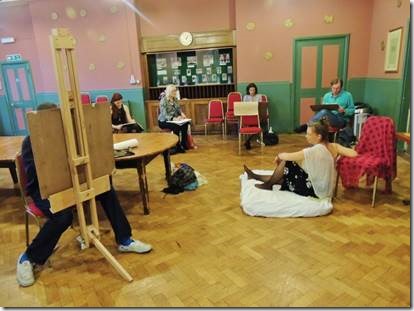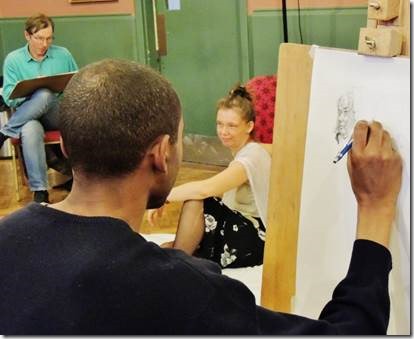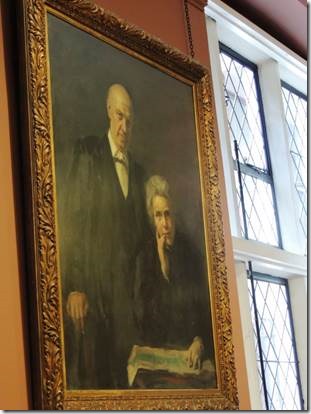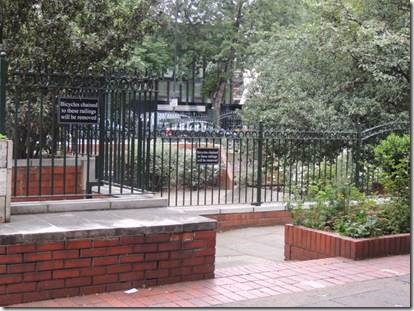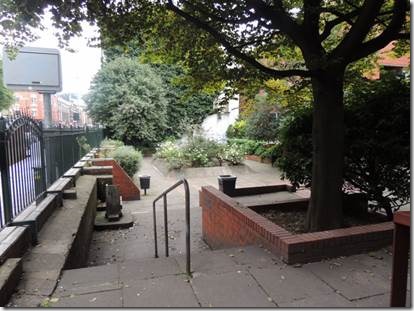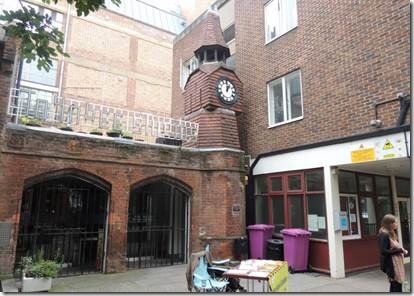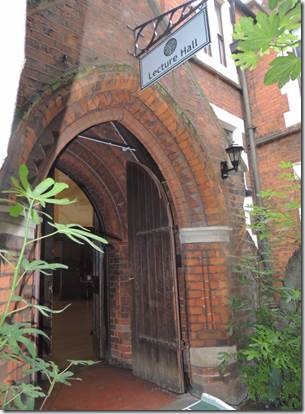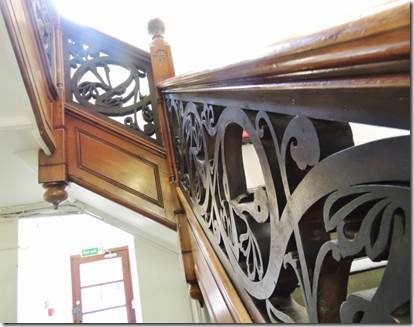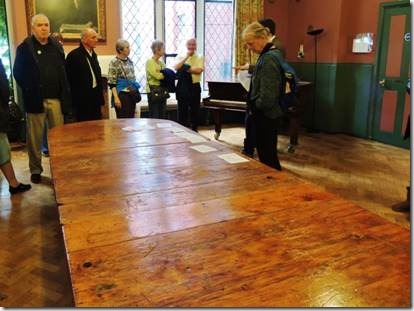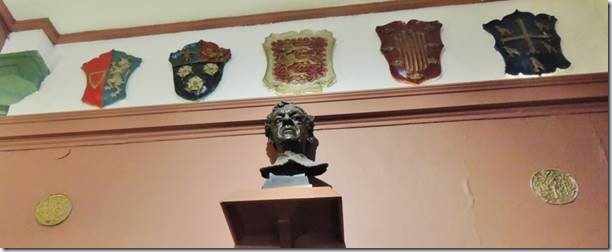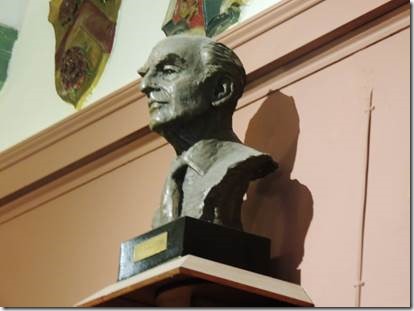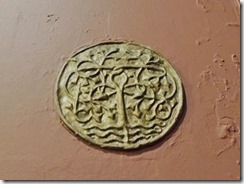Cheers,
Today Sue Ed and I walked to the Artizan Public Library to get library cards. My Canary Wharf card is good for Tower Hamlets libraries but not for city libraries or something like that. Artizan is much closer so will probably be the one we’ll all use most. I saw several books I’ll enjoy reading when we return. So nice to have a library!
This email is about the second venue we visited on Open London weekend. Toynbee Hall is the original Settlement House prototype. In elementary school I wrote a paper about Jane Addams, founder of Hull House settlement house in Chicago and first woman to win the Nobel Peace Prize. I also wrote a paper that included mention of Dorothea Dix and her work to create facilities for the humane treatment of the mentally ill who until then were often housed in jails.
The Settlement Cookbook
Lizzie Black Kander, author of The Settlement Cookbook, was born in Milwaukee, on May 28, 1858. Like many middle-class Jewish women of her time, she was deeply involved in Progressive Era reform movements that sought to aid and Americanize immigrants. Kander first became involved in local reform efforts in 1878, when she joined Milwaukee’s Ladies Relief Sewing Society. Under Kander’s leadership, the Society evolved into the Milwaukee Jewish Mission. It was as president of "the Settlement," Milwaukee’s first settlement house, a multi-purpose reform organization modeled on Jane Addams’s Hull House, that Kander made her most lasting contribution.
Among the Settlement’s programs was a series of cooking classes for immigrants. In 1901, Kander asked the Settlement’s board for $18 to print a small booklet of recipes for her students. When the board refused, she raised money from the local business community and produced the first edition of The Settlement Cookbook, which combined her recipes with instructions on cleanliness and food storage and general housekeeping tips. The first edition of the Cookbook was published on April 30, 1901. By 2004, The Settlement Cookbook, still in print, had gone through 40 editions and sold over 1.5 million copies, making it the most successful American Jewish charity cookbook of all time. http://jwa.org/node/12629
My mother had one , probably her mother’s that now my sister has. It’s called The Settlement Cookbook. Maybe the same, but if not, definitely the same idea.
So it’s not so surprising that I was interested in the history of Toynbee Hall and went off on dozens of tangents. Toynbee involves the lives of “everyday” people not kings, queens or generals. My write up of the Tower of London will probably take about 2 paragraphs! But most folks know about the Tower of London; very few know Toynbee Hall. Now you do.
Ru
DoraMac
Toynbee Hall
“Toynbee Hall was founded in 1884, born out of the ideals of the settlement movement. This was a reform movement whose aim was to alleviate poverty through creating new communities, in which the rich and the poor lived closely together, sharing skills and knowledge.”
http://www.toynbeehall.org.uk/toynbee-hall-archives
“Although used earlier by French writers, the term Industrial Revolution was first popularized by the English economic historian Arnold Toynbee (1852–83) to describe England’s economic development from 1760 to 1840.”
Toynbee pushed for society to improve the lives of working people. Toynbee Hall was named as a memorial to him.
What it does now…
“Toynbee Hall is a community organisation that pioneers ways to reduce poverty and disadvantage in the East End of London. We give some of the country’s most deprived communities a voice, providing access to free advice and support services and working with them to tackle social injustice.
Tower Hamlets is characterised by high rates of child poverty, worklessness, mortality and overcrowding. The majority of the 9,000 people we worked with in 2011/12 live on very low incomes, have multiple needs, low aspirations or poor health. We work with them to identify the services they need to improve their lives, and provide an opportunity for them to take action on community issues.
Our work is themed across four different programme areas: Advice, Youth & Community, Financial Inclusion and Wellbeing. Our service users are diverse, and include young people, older people, new migrants, people who are financially excluded, people facing serious legal issues, as well as people from different communities.
Our services are free of charge, and every year nearly 500 residential and non-residential volunteers support us to deliver services and engage with communities across Tower Hamlets and beyond.”
|
http://www.toynbeeartclub.org.uk/ Toynbee Art Club Established in 1886 by Architect Designer Charles Robert Ashbee. Chair: Irene Lafferty M.A. We are a friendly and lively art group meeting on Sundays from 2.30 to 5pm throughout the year for Life Drawing at Toynbee Hall, 28 Commercial Street, London E1 6LS. Those attending the life sessions cover a range of abilities from professional artists to newcomers. These workshops are ideal for art students developing their practice. There is a strong group dynamic. We welcome beginners and people from all ages and backgrounds. Please bring your own art materials. Drawing sessions are held in the Arts and Crafts Lecture Hall designed by C.R Ashbee. Allow extra time for parking as there is a vibrant local street markets on Sundays. Session Fee: £6. Student and unwaged rate: £4 pay as you go. |
|
Charles Robert Ashbee was born in London, the son of a prosperous city merchant. Educated at Wellington College and King’s College, Cambridge, he was articled to G. F. Bodley. While working in Bodley’s office Ashbee lived at Toynbee Hall, the pioneer University Settlement in Whitechapel where he initiated classes in art and craft which become the nucleus of the School of Handicraft (1887) and the Guild of Handicraft (1888). The Guild is now chiefly known for the metalwork and jewellery designed by Ashbee himself, and for the furniture made for the Grand Duke of Hesse in collaboration with the designer M. H. Baillie Scott in the workshops at Essex House in the Mile End Road. In 1902 Ashbee undertook his grand experiment and removed the entire Guild to Chipping Campden in the Cotswolds. For a while the Guild’s affairs prospered, but from 1905 the receipts from the craftwork fell off disastrously and by 1907 the company was forced into voluntary liquidation. Ashbee continued throughout this period with his architectural practice, which brought in a number of decorotive commissions to the Guild. He designed two groups of houses in Cheyne Walk, Chelsea and a number of squat, square houses in the country, some of which feuture in A Book of Cottages and Little Houses. http://www.victorianweb.org/art/design/ashbee/ http://www.courtbarn.org.uk/ashbee site of the Museum of Crafts and Design in Chipping Campden which shows examples of his work. Ashbee buckle photo from the courtbarn site |
|
There is a point to the digression…. Henrietta Barnett and her husband Samuel, founders of Toynbee Hall were great supporters of art for everyone as well as being the originators of the Settlement House Philosophy. Henrietta Octavia Barnett née Rowland (1851- 1936) social reformer. Her career began as one of the voluntary workers for housing pioneer Octavia Hill in Marylebone. She married Samuel Barnett and they jointly founded the University Settlement, Toynbee Hall in Whitechapel, London. She extended this system of social work to America and was its President. The Barnetts also demolished slum dwellings in Whitechapel and built model dwellings on Octavia Hill’s principles. Henrietta Barnett was involved in supporting working women through women’s trade unions such as the Women’s Protective and Provident League and the National Union of Women Workers as well as being a suffrage supporter. Barnett also worked with Angela Burdett-Coutts on assisting poor children. Believing that working people should have access to art, she founded the Whitechapel Art Gallery. (Seth Koven, ‘Oxford Dictionary of National Biography’, 2004) http://www.english-heritage.org.uk Samuel and Henrietta Barnett Henrietta is holding her plans for Hampstead Garden Suburb : a community of individual homes and gardens mixing families of all incomes rather than house them in huge housing projects. Toynbee Hall was created in 1884 by Samuel Barnett, a Church of England curate, and his wife Henrietta, in response to a growing realisation that enduring social change would not be achieved through the existing individualised and piecemeal approaches.
The radical vision was to create a place for future leaders to live and work as volunteers in London’s East End, bringing them face to face with poverty, and giving them the opportunity to develop practical solutions that they could take with them into national life. Many of the individuals that came to Toynbee Hall as young men and women – including Clement Attlee and William Beveridge – went on to bring about radical social change and maintain a lifelong connection with Toynbee Hall. http://infed.org/ Henrietta Barnett http://www.hbschool.org.uk/ A girls school located in Hampstead Garden Suburb, the community designed by Henrietta Barnett |
|
Jane Addams, founder of Hull House and a leader of the Settlement House philosophy in America, and the first woman in America to win the Nobel Prize….and the topic of a paper I wrote in elementary school! Jane Addams to Sarah Alice Addams Haldeman On her return to England in the summer of 1888, Jane Addams expressed great interest in the proceedings of the Foreign Missions Congress and in Toynbee Hall, the social settlement experiment pioneered by Rev. Samuel A. Barnett and his wife Henrietta. At a chance meeting in Canterbury, Addams encountered Barnett’s mentor, Canon William Henry Fremantle, who provided her with a letter of introduction to Toynbee Hall. After signing the visitors’ register, she and traveling companions Helen Harrington and Sarah F. Anderson, friends from Rockford Female Seminary days, toured the distinctive red-brick structure which had opened in 1885 on Commercial Street in London, not far from Barnett’s parish of St. Jude. Addams’s letter to her sister, Sarah Alice Addams Haldemann, excerpted here, captures the excitement she experienced during her visit to Toynbee Hall. 3 Woburn Place London [England] June 14" 1888 My dear Alice . . . We have been in London since Monday. I wrote you I think of Amiens, Rouen and Rheims. We had a pleasant crossing from Boulogne to Folkstone and five days of delightful rest at Canterbury. . . . We have found a cheap boarding place & comfortable withal altho not luxurious. I have been very much interested in the World Centennial of Foreign Missions held in Exeter Hall. 2 Miss Anderson and I have been to a good many of the meetings and one evening on the Opium trade in China and the Liquor traffic on the Congo, was one of the most exciting meetings I ever attended. The questions were so political in character that they were defended on that ground, an old India office[r] even quoting scripture in defense of the opium traffic. I have become quite learned on foreign missions and ashamed of my former ignorance. The most interesting thing that we have done in London was a visit to the Toynbee Hall in the East End. It is a community of University men who live there, have their recreating[,] <clubs> & society all among the poor people yet in the <same> style they would live in their own circle. It is so free from "professional doing good" so unaffectedly sincere and so productive of good results in its classes and libraries &c that it seems perfectly ideal. We are going to the People’s Palace 3 some evening. I don’t know but that the Mission Side of London is the most interesting side it has. We have been reading Walter Besant His "Children of Gideon" and "All Sorts & Conditions of Man," the latter suggested the People Palace since worked out. 4 . . . Always dear Alice, Yrs Jane Regards to my many friends[.] ALS (University of Illinois at Chicago, Jane Addams Memorial Collection, Haldeman-Julius Family Papers; JAPM, 2:968-73; JAP, 2:620-21). |
|
Mallon Garden This area on Commercial Street borders Toynbee Hall. Originally there was a factory here which fell to disrepair and then was completely distroyed during the war. The economic and social crises in East London in the 1860s had an important effect on the activities of philanthropists and led to the establishment of one of the most enduring institutions in East London: the Settlement House. Toynbee Hall, Commercial Street, was founded by Canon Samuel Barnett, vicar of St Jude’s Whitechapel in memory of Arnold Toynbee, a young Oxford Historian who pioneered social work in East London. The original building of 1884-5 by Elijah Hoole survives only in part. It is set well back from the street behind gardens; rather like an Elizabethan manor house with some agreeable, if undistinguished, additions in recent decades. Tudor-style four bay red-brick facade with burnt end diapering to the brickwork, stone dressings, large mullioned windows with diamond leaded panes under a pair of steep kneelered gables and robust chimney stacks. Before war damage, the Hall was set around a narrow quadrangle of secluded collegiate character, screened by warehouses to the street and entered through an arched opening at the base of a tall gatehouse with mullion windows and oriel window to the first floor. In the upper storey, rooms for residential workers, above a drawing room, meeting hall and a dining room decorated by C.R Ashbee’s art students. Of this only gilded plaster roundels survive, embellished with a motif of a tree formed from a stylised "T". Later additions are mixed but the resolutely modernist Toynbee Studios, of 1939 by Alister G. MacDonald, for theatre, music school and juvenile court, makes an unsentimental contrast to Hoole’s neo-Tudor hall and points at the changing emphasis from manorial residence to a 20th century community centre. |
|
A haven for Jewish immigrants. World’s first Jewish Scout troop was housed at Toynbee Hall : the clocktower was their “thank you.” “Classes included English, art, and dressmaking were provided along side free legal aid, country holiday funds, and a toy library. …For over 75 years , until 2011, the Friends of Yiddish met here every Saturday afternoon. Dufning WW2, the Jewish market traders donated food and clothes to the distribution depot at Toynbee Hall. Jewish London by Kolsky and Rawson |
|
Where we began our tour! |
|
Entrance to the Lecture Hall An elegant, wood-panelled interior, with a wooden floor, marble fireplace, latticed windows and mullioned surrounds. The Hall was the setting for Marconi’s first public radio broadcast demonstration that took place in 1896. In addition to this, the Lecture Hall has hosted speakers including Lenin, Gandhi, several Archbishops of Canterbury and at least three Prime Ministers. |
|
The original Arts & Crafts bannister |
|
Ashbee Hall The Ashbee Hall is named after Charles Ashbee, a contemporary of William Morries and leading figure in the English Arts and Crafts movement, who formed the Guild of Handicraft in 1888 at Toynbee Hall. Latticed windows with mullioned surrounds, wooden flooring and a marble and wood fireplace all help to create a unique atmosphere in this historic room, which was originally used as the dining room for Toynbee Hall’s first residential volunteers. The original wooden dining table, which is still in use today, can be used as part of your event. Lecture Hall with the original low meeting table. We were told that the height of the table was determined by the requirement that comfortable armchairs could be used around it. http://www.toynbeehall.org.uk/venues/52/ashbee-hall |
|
James Joseph Mallon (1874–1961), by Sir Jacob Epstein, 1954 “In October 1919 Mallon was appointed warden of Toynbee Hall, a position he was to hold until his retirement in April 1954. There were some misgivings at first since he was not an ‘Oxford man’, but Jimmy soon became known as a born committee man, conscientious but with a welcome touch of conviviality, even of irreverence. At Toynbee Hall he was the life and soul of an established institution, the place of which in local and in national life was changing considerably during Mallon’s long and popular wardenship. Above all, he strengthened its community links and emphasized its educational activities, so that it was sometimes known in his time as ‘the poor man’s university’. He had been an early member of the executive committee of the Workers’ Educational Association, of which he later became honorary treasurer, and was prominent in its counsels. He was a strong advocate of raising the school-leaving age and of expanding further and higher education, including part-time education. He was closely associated, too, with the Workers’ Travel Association. In bodies like this he found his ideals realized. During his wardenship three significant pieces of legislation, the Public Order Act (1936), the Education Act (1936), and the Hire Purchase Act (1939), were influenced by initiatives at Toynbee Hall.” http://www.oxforddnb.com/templates/article.jsp?articleid=34846&back One of the peculiarities of life at Toynbee is that it calls itself *the* university settlement in East London, but it has neither student interns nor any enduring relationship to any institution of higher learning-much less to Oxford or Cambridge whose college coats of arms ring the great hall. http://comm-org.wisc.edu/papers96/milofsky.html |
|
Jack Profumo John Profumo, once famous for the “Profumo Affair” became a humble worker for Toynbee Hall John Profumo Icon of Toynbee HallJohn Profumo – Jack as he was know to his friends – came to Toynbee Hall as a volunteer in 1963 and continued until his death on 9 March 2006; by far the longest serving volunteer. http://www.toynbeehall.org.uk/jack-profumo How to Find Grace After Disgrace New York’s politicians could learn from an Englishman’s example. “Because Profumo believed in remorse of conscience—because he actually had a conscience—he could absorb what happened and let it change him however it would. In a way what he believed in was reality. He’d done something terrible—to his country, to his friends, to strangers who had to explain the headlines about him to their children. He never knew political power again. He never asked for it. He did something altogether more confounding. He did the hardest thing for a political figure. He really went away. He went to a place that helped the poor, a rundown settlement house called Toynbee Hall in the East End of London. There he did social work—actually the scut work of social work, washing dishes and cleaning toilets. He visited prisons for the criminally insane, helped with housing for the poor and worker education. And it wasn’t for show, wasn’t a step on the way to political redemption. He worked at Toynbee for 40 years. He didn’t give interviews, never wrote a book, didn’t go on TV. Alistair Horne: "Profumo . . . spent the rest of his life admirably dedicated to valuable good works, most loyally supported by his wife. At regular intervals, some journalist writing ‘in the public interest’ would rake up the old story to plague the ruined man and cause him renewed suffering. His haunted, unsmiling face was a living epitaph to the ‘Swinging Sixties.’" In November 2003, to mark the 40th anniversary of his work, Profumo gave an interview to an old friend. "Jack," said W.F. Deedes, "what have you learnt from this place?" After a pause for thought, Profumo said: "Humility." http://online.wsj.com/ |
|
C.R Ashbee’s art students. …. Of this only gilded plaster roundels survive, embellished with a motif of a tree formed from a stylised "T". |
|
open letter to The Century, May 1887….. Victorian London – Education – Education for the poor – Toynbee Hall AN INTERESTING SOCIAL EXPERIMENT. ONE of the most interesting features of London of to-day is the work of the “West End” among the poor of the “East End,” and chiefly in this the University settlement housed at Toynbee Hall, Commercial Road, Whitechapel, next to that center of working religion, St. Jude’s Church. The Rev. Samuel A. Barnett, rector of St. Jude’s, whose name is known to all students of charity organization, is also senior warden of Toynbee Hall, and his assistant, the Rev. T. C. Gardiner, is sub-warden. With them are fifteen or twenty men, most of them graduates of Oxford or Cambridge, some of them busy in the city, others men of leisure and wealth,— all of them giving more or less of their time to the work of making the lives of the East End poor more wholesome and beautiful than they could be without such help. The hall is named after Arnold Toynbee, one of the scholars of Balliol College, Oxford, who had interested himself deeply in social questions, and through whose efforts in great part the Cooperative Congress was invited to Oxford in 1881. He was a reader in political economy in his college and its bursar or business man, so that he had both a theoretical and practical knowledge of economics, and his interest in the subject was therefore two-sided. When Henry George’s lectures attracted so much attention in England, Toynbee thought that some features or results of them should be counteracted, and he therefore arranged to give two lectures at St. Andrew’s Hall, London, in which he discussed the betterment of the condition of the working classes from his point of view. The audience, I was told, was a curiously mixed one, containing a good many from the social stratum to which Toynbee belonged, as well as the workingmen hearers whom he particularly invited; and among the latter there was a decided undercurrent of criticism and not a little interpellation of the speaker. In the course of the lectures he had confessed that his own class was largely responsible for the discontent among the working classes, and he said frankly that the evil would not come to an end until “we” were willing to live for and if necessary to die for “you.” He was frail; the lectures had excited him greatly; and at the close of the last he fell back in his chair fainting. He was taken to the house of friends in the country, and there died. His sudden end threw a halo of pathos upon his lectures and his work, and when the University men decided to start this colony in London the buildings became a memorial to him. His family is well known in London for its devotion to philanthropic work, and several of his brothers and sisters are still active in the work to which he gave his life. Toynbee Hall had its actual origin in Oxford. In the spring of 1884, a few months after Toynbee’s death, Mr. Barnett read a paper at a small meeting in St. John’s College, in which he shadowed forth his idea of what a colony of University men might do for industrial centers such as East London. The paper, though read to a small knot of men, was published and soon won its way, and a small group of University men made an experiment in associated life at a disused public house, under Mr. Barnett’s guidance and help, when the success of the experiment justified a permanent home. The friends of Arnold Toynbee, who had been anxious to erect some memorial of his work and enthusiastic self-devotion, provided most of the funds for a lecture- hall, and the cost of the rest of the buildings was defrayed by a company formed for this purpose, which raised about £10,000 on the security of the freehold land, bearing interest at 4½ per cent. Toynbee Hall, while a memorial to Arnold Toynbee, is also a monument to Samuel A. Barnett, whose ideas it embodies. One enters from the Commercial Road through the ordinary English gateway into a sort of quadrangle, on one side of which is the residence part of Toynbee Hall, and on the other a lecture-hall wlhch is filled nearly every evening for some purpose or other with East End people. This latter building is also used as a general headquarters for organized charity in the district, including, for instance, the office of the Beaumont Trust, from which the People’s Palace, prophesied in Kingsley’s “Alton Locke,” and made almost real in Walter Besant’s “All Sorts and Conditions of Men,” is now rising into solid fact. The East London Antiquarian Society, the Adam Smith Club, the Toynbee Natural History Society, the Education Reform League, the Pupil Teachers’ Debating Society, the Toynbee Shakespeare Club, the Students’ Union, and still other organizations, hold their meetings in Toynbee Hall or in St. Jude’s school next door. The hall is as beautiful a club-house as one would wish at the West End itself, and certainly no more charming host could be found through Belgravia and Mayfair than the junior warden. Each man has his room or suite of rooms, as he would have at college, and the charming drawing-room, with comfortable and cozy furniture and beautiful adornments, forms a general gathering-place for the club-men and their guests. We had “afternoon tea” there, in strange contrast with the surroundings of poverty and squalor in the streets about, and here Mr. Gardiner told us something of the practical work of the colony and its difficulties. Four evenings of the week are devoted, in the lecture-room opposite, to courses of lectures respectively on history, physiology, astronomy, and English Literature, the fee being one shilling for each complete course. Another evening there is a concert, and always on Saturday evening a “popular” lecture. The sixth evening of the week is given to a social reception in the drawing-room of the club-house, where the men of Toynbee Hall are assisted by friends from the West End in receiving and entertaining the poor people of the neighborhood. The difficulties of mingling classes are, after all, much the same in England as at home. There is a good deal of human nature everywhere. I asked Mr. Gardiner what kind of people proved the best entertainers. He replied that those who were popular at the West End were popular at the East, and there was, indeed, great difficulty in getting the right sort of people, because they were so much in demand in their own class of "society." Some practiced “entertainers,” as they call them, could interest easily eight or ten of the poorer people, whereas others could take care of only one or two. The chief difficulty to overcome was the narrow sphere in which the poorer people did their thinking and their talking, and the whole purpose of these receptions, and of much of the other work, was to broaden the mental horizon of these people, and give them more and pleasanter things to think and talk about outside of the narrow circle of their tenement-house or neighborhood gossip. These men were hoping to accomplish much through the "national teachers," — young men and women selected from the ranks of trades-people and the like, without much culture themselves, but who could be made the means of spreading the wider life among their pupils when they came to teach. To this end they organized reading-parties, as was the fashion at the universities, for those who showed special interest in the weekly lectures, and one or two of their best outdoor men were charged with forming cricket and tennis clubs and other outdoor circles, to broaden the life of their protégés in those directions. The classes and reading-parties are organized into groups, each under the management of an Honorary (unpaid) Secretary. One group comprises one class studying the Old Testament, another studying moral philosophy, a course of Sunday afternoon lectures on the Ethics of the Ancient and Modern World, three classes in Victorian literature (one entirely of women), one in English history, two in political economy. A second group includes reading-parties on Mazzini, Ruskin, and literature, to each of which admission is by election, and classes in French, German, and Latin. Another group covers the physical sciences and includes an ambulance class. A fourth comprises singing-classes, instruction and entertainment for deaf and dumb, drawing-classes, elementary evening classes for boys, lantern illustrations in geography for boys, musical drill for boys, and several classes in short- hand. A fifth provides instruction and practice in carpentering, in wood-carving and in modeling, both for hoys and men. The work of Toynbee Hall is in the right direction, and, moreover, it is justified not only by its results but by the enjoyment which men have in the doing of it. “ I could not give up this East End work,” said one of them to me; “I could not live my life in content away from the people I have learned to know and love here.” .R. R. Bowker. open letter to The Century, May 1887 http://www.victorianlondon.org/education/toynbee.htm |
|
“ Toynbee Hall, the original university settlement located in East London, is both among the famous social service organizations in the world and an example of a "permanently failing organization." This paper shows that the present malaise afflicting Toynbee is but the latest manifestation of an organizational confusion and fiscal anemia that has plagued the organization throughout its history, even during the period when R.H. Tawney ran Children’s Country Holiday Fund, William Beveridge was Vice-Warden, and Beatrice Webb regularly came by for tea. Recent critics in the U.K. have used the example of Toynbee as an argument for more clearly defined and stringently applied accounting procedures for charitable organizations. This paper argues, in contrast, that the genius of Toynbee rests in its very confusion and disorganization. The organization has a subtle and powerful organizational culture that resists rationalization. It is precisely the persistence of this culture that has enabled Toynbee to be one of the most powerful sources of social innovation in the Anglo-American tradition for providing social services.” http://comm-org.wisc.edu/papers96/milofsky.html THE FORCE OF TRADITION AT TOYNBEE HALL CULTURE AND DEEP STRUCTURE IN ORGANIZATIONAL LIFE Carl Milofsky Department of Sociology and Anthropology Bucknell University Lewisburg, PA 17837 (717) 514-3468 and Albert Hunter Department of Sociology Northwestern University Evanston, IL 60201 (708) 491-3804 This paper was prepared for presentation at a special meeting of the Voluntary Action History Society, London, January, 1993. Research for this paper was supported by the Changing Dimensions of Trusteeship Project, Program on Nonprofit Organizations, Yale University, funded by the Lilly Endowment. |

